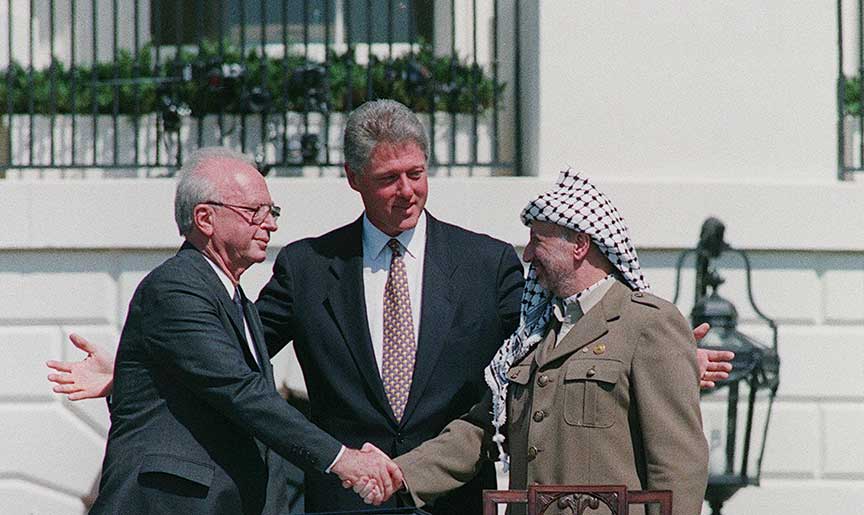1993 Israel PLO Accord

Israel and the Palestinian Liberation Organization reached an accord on an Israeli withdrawal from the Gaza Strip and the West Bank town of Jericho. This interim agreement called for further negotiations on the status of the rest of the West Bank. The tentative agreement was signed in Washington on September 13th; the full accord was signed in Cairo in May 1994.
Following the end of the Gulf War, the United States convened the Madrid Peace Conference to attempt to resolve the Arab-Israeli conflict. In 1991, Yitzhak Rabin was elected Prime Minister of Israel. He was convinced that Israel needs to find a method to come to peace with its neighbors. He preferred reaching an agreement with the Syrians first, but when that route seemed blocked, he gave the green light to secret contacts between representatives of the Foreign Ministry and representatives of the Palestine Liberation Organisation. The meeting took place in Oslo, and there the two sides reached what came to be known as the Oslo Accords.
Main Provisions of the Accords
• Mutual Recognition: In what was a historic breakthrough, the PLO recognized the state of Israel's right to exist in peace and security. In return, Israel acknowledged the PLO as the legitimate representative of the Palestinian people.
• Phased Withdrawal from the West Bank and Gaza: The accords laid out a plan for the Israeli Defense Forces (IDF) to withdraw from parts of the West Bank and Gaza Strip. In return, the PLO renounced terrorism and other forms of violence.
• Establishment of Palestinian Self-Governance: The accords proposed limited self-rule for Palestinians in the West Bank and Gaza in the form of an interim government—the Palestinian Authority (PA). This body would have authority over most areas except external security and foreign affairs.
• Further Negotiations: The accords set a five-year timeline for negotiations to address unresolved issues, such as the status of Jerusalem, Palestinian refugees, Israeli settlements, and borders.
Symbolic Significance and Outcomes
On September 13, 1993, under the watchful eyes of international leaders and with U.S. President Bill Clinton as a mediator, Israeli Prime Minister Yitzhak Rabin and PLO Chairman Yasser Arafat shook hands and signed the Declaration of Principles on the White House lawn. This gesture, previously unthinkable, was seen by many as the dawn of a new era.
In subsequent years, further agreements were signed under the Oslo framework. These included the Cairo Agreement of 1994 and the Oslo II Accord in 1995, further detailing the territorial divisions and powers of the PA.
 >
>